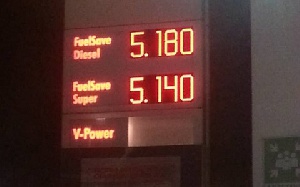 The increment according to IES may be due to increment in crude oil prices
The increment according to IES may be due to increment in crude oil prices
Fuel prices will rise “substantially at the pump” in February, the Institute of Energy Security (IES) is forecasting.
The IES said a liter of fuel could go beyond Ghc5 due to increment in crude oil prices on the world market.
“This is explained by the fact that crude and finished product prices have shot up on the international market, with Gasoil seeing a substantial increment of 6.17 percent and average Brent crude price going up by 7.47 percent over the past two weeks.
“The depreciation of the Cedi by 2 percent remains the single key variable in eroding the price gains on the local fuel market over the past weeks, and moving a liter of fuel (especially Gasoil) beyond the Ghc5 per liter threshold once again,” the Institute said in a statement.
However, the IES noted “some Oil Marketing Companies (OMCs) are likely to keep their prices stable to attract or maintain market shares in today’s competitive fuel market.”
Below is the full statement:
CEDI DEPRECIATION TO ERODE GAINS IN FUEL PRICES
REVIEW OF JANUARY 2019 SECOND PRICING-WINDOW
Local Fuel Market Performance
For the first time since November 2018, fuel prices shot up at the pump within the Pricing-window under review. Major Oil Marketing Companies (OMCs) adjusted prices of both Gasoline and Gasoil upward by Ghp0.02 per liter. Average price for both Gasoline and Gasoil stood at Ghc4.94, representing a marginal increment of 0.40 percent over the previous selling price of Ghc4.92 per liter across major fuel outlets.
IES Market-Scan has it that within the period under review; Benab Oil, Zen Petroleum, Fraga Oil, Pacific Oil and Frimps Oil sold the least-expensive fuels relative to other OMCs on the local fuel market.
World Oil Market Prices
The window opened with Brent crude trading at $58.99 per barrel, rising to hit a high of $62.74 per barrel before declining to $61.59 per barrel. But on average terms, Brent crude price increased by 7.56 percent to $61.29 per barrel over the period. This happened on the back of the crisis in Venezuela, the US-China trade conflict and the International Monetary Fund (IMF) new economic growth forecast which lowered its global growth estimate to 3.5 percent this year, down 0.2 percent from its October 2018 estimate. While the U.S. considers possible sanctions on Venezuela, the oil-producing country has seen its production continue to decline. At the same time, Russia has signaled its commitment to stick to OPEC+ production cut. Estimates from Standard and Poor’s Global Platts benchmark for finished products, shows that Gasoil prices increased significantly by 6.17 percent to close trading at $566.78 per metric ton, over a previous price of $533.85 per metric ton. However Gasoline recorded a marginal increment of 0.40 percent, to close trading at $500.28 per metric ton, from previous trading figure of $498.25 per metric ton.
Local Forex and Fuel Stock
IES Economic Data shows the local currency had a relatively heavy depreciation of 2 percent against the Dollar over the period, trading at Ghc5.05 as against Ghc4.95 in the last Pricing-window. Approximately 170,000 metric tons of Gasoil, Gasoline, Butane, and Aviation Turbine Kerosene were discharged from vessels to add on to the country’s stock of fuel over the period.
IES PROJECTIONS FOR FEBRUARY 2019 FIRST PRICING-WINDOW
After more than six (6) Pricing-windows of continuous fuel price declines and stability, the Institute for Energy Security (IES) foresees fuel price rising substantially at the pump. This is explained by the fact that crude and finished product prices have shot up on the international market, with Gasoil seeing a substantial increment of 6.17 percent and average Brent crude price going up by 7.47 percent over the past two weeks. The depreciation of the Cedi by 2 percent remains the single key variable in eroding the price gains on the local fuel market over the past weeks, and moving a liter of fuel (especially Gasoil) beyond the Ghc5 per liter threshold once again. Some Oil Marketing Companies (OMCs) are likely to keep their prices stable to attract or maintain market shares in today’s competitive fuel market.
Signed: MIKDAD MOHAMMED (Research Analyst, IES)